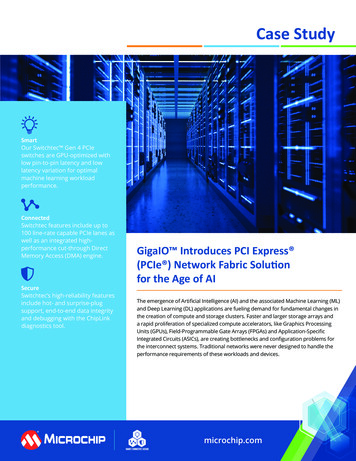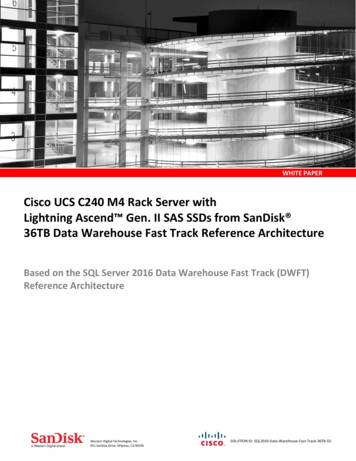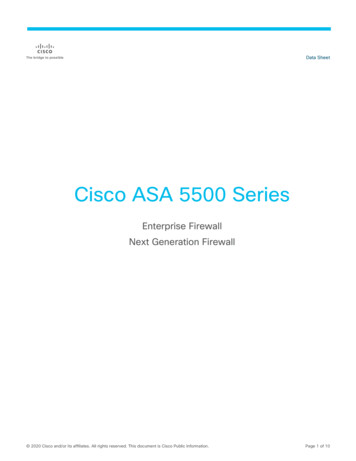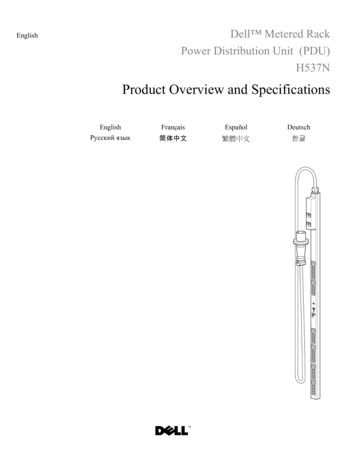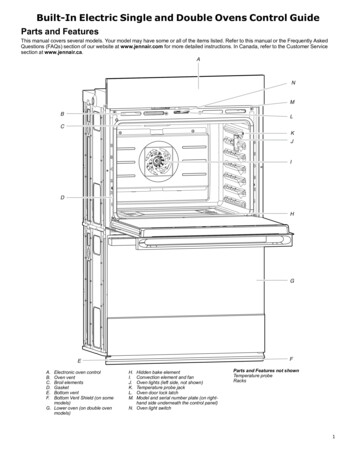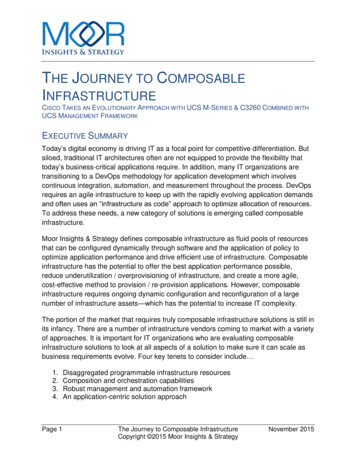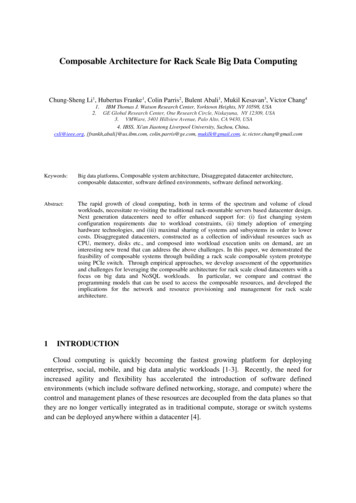
Transcription
Composable Architecture for Rack Scale Big Data ComputingChung-Sheng Li1, Hubertus Franke1, Colin Parris2, Bulent Abali1, Mukil Kesavan3, Victor Chang41. IBM Thomas J. Watson Research Center, Yorktown Heights, NY 10598, USA2. GE Global Research Center, One Research Circle, Niskayuna, NY 12309, USA3. VMWare, 3401 Hillview Avenue, Palo Alto, CA 9430, USA4. IBSS, Xi'an Jiaotong Liverpool University, Suzhou, China .csli@ieee.org, {frankh,abali}@us.ibm.com, colin.parris@ge.com, mukilk@gmail.com, ic.victor.chang@gmail.comKeywords:Big data platforms, Composable system architecture, Disaggregated datacenter architecture,composable datacenter, software defined environments, software defined networking.Abstract:1The rapid growth of cloud computing, both in terms of the spectrum and volume of cloudworkloads, necessitate re-visiting the traditional rack-mountable servers based datacenter design.Next generation datacenters need to offer enhanced support for: (i) fast changing systemconfiguration requirements due to workload constraints, (ii) timely adoption of emerginghardware technologies, and (iii) maximal sharing of systems and subsystems in order to lowercosts. Disaggregated datacenters, constructed as a collection of individual resources such asCPU, memory, disks etc., and composed into workload execution units on demand, are aninteresting new trend that can address the above challenges. In this paper, we demonstrated thefeasibility of composable systems through building a rack scale composable system prototypeusing PCIe switch. Through empirical approaches, we develop assessment of the opportunitiesand challenges for leveraging the composable architecture for rack scale cloud datacenters with afocus on big data and NoSQL workloads. In particular, we compare and contrast theprogramming models that can be used to access the composable resources, and developed theimplications for the network and resource provisioning and management for rack scalearchitecture.INTRODUCTIONCloud computing is quickly becoming the fastest growing platform for deployingenterprise, social, mobile, and big data analytic workloads [1-3]. Recently, the need forincreased agility and flexibility has accelerated the introduction of software definedenvironments (which include software defined networking, storage, and compute) where thecontrol and management planes of these resources are decoupled from the data planes so thatthey are no longer vertically integrated as in traditional compute, storage or switch systemsand can be deployed anywhere within a datacenter [4].
The emerging datacenter scale computing, especially when deploying big dataapplications with large volume (in petabytes or exabytes), high velocity (less than hundredsof microsecond latency), wide variety of modalities (structure, semi-structured, and nonstructured data) involving NoSQL, MapReduce, Spark/Hadoop in a cloud environment arefacing the following challenges: fast changing system configuration requirements due tohighly dynamic workload constraints, varying innovation cycles of system hardwarecomponents, and the need for maximal sharing of systems and subsystems resources [5-7].These challenges are further elaborated below.Figure 1 Traditional datacenter with serversand storage interconnected by datacenternetworks.Systems in a cloud computing environment often have to be configured differently inresponse to different workload requirements. A traditional datacenter, as shown in Fig. 1,includes servers and storage interconnected by datacenter networks. Nodes in a rack areinterconnected by a top-of-rack (TOR) switch, corresponding to the leaf switch in a spineleaf model. TORs are then interconnected by the Spine switches. Each of the nodes in a rackmay have different CPU, memory, I/O and accelerator configurations. Several configurationchoices exist in supporting different workload resource requirements optimally in terms ofperformance and costs. A typical server system configured with only CPU and memorywhile keeping the storage subsystem (which also includes the storage controller and storagecache) remote is likely to be applicable to workloads which do not require large I/Obandwidth and will only need to use the storage occasionally. This configuration is usuallyinexpensive and versatile. However, its large variation in sustainable bandwidth and latencyfor accessing data (through bandwidth limited packet switches) make it unlikely to performwell for most of the big data workloads when large I/O bandwidth or small latency foraccessing data becomes pertinent. Alternatively, the server can be configured with largeamount of local memory, SSD, and storage. Repeating this configuration for a substantial
portion of the datacenter, however, is likely to become very expensive. Furthermore,resource fragmentation arises for CPU, memory, or I/O intensive big data workloads as theseworkloads often consume one or more dimensions of the resources in its entirety while leftother dimensions underutilized (as shown in Fig. 2, where there exists unused memory forCPU intensive workloads (Fig. 2(b)) or unused CPU for memory intensive workloads (Fig.2(c)). In summary, no single system configuration is likely to offer both performance andcost advantages across a wide spectrum of big data workload.Traditional systems also impose identical lifecycle for every hardware component insidethe system. As a result, all of the components within a system (whether it is a server, storage,or switches) are replaced or upgraded at the same time. The "synchronous" nature ofreplacing the whole system at the same time prevents earlier adoption of newer technology atthe component level, whether it is memory, SSD, GPU, or FPGA. The average replacementcycle of CPUs is approximately 3-4 years, HDDs and fans are around 5 years, batterybackup (i.e. UPS), RAM, and power supply are around 6 years. Other components in a datacenter typically have a lifetime of 10 years. A traditional system with CPU, memory, GPU,power supply, fan, RAM, HDD, SSD likely has the same lifecycle for everything within theFigure 2: Fitting workloads to nodes in a cloud environment. (a) Typical workloads where CPU andmemory requirements can be easily fit into a system. (b) CPU intensive workload with unused memorycapacity. (c) Memory intensive workloads.system as replacing these components individually will be uneconomical.System resources (memory, storage, and accelerators) in traditional systems configuredfor high throughput or low latency usually cannot be shared across the data center, as theseresources are only accessible within the "systems" where they are located. Using financialindustry as an example, they are often required to handle large number of Online TransactionProcessing (OLTP) during day time while conducting Online Analytical Processing (OLAP)and business compliance related computation during night time (often referred to as batchwindow) [8]. OLTP has very stringent throughput, I/O, and resiliency requirements. Incontrast, OLAP and compliance workloads may be computationally and memory intensive.As a result, resource utilization could be potentially low if systems are statically configuredfor individual OLTP and OLAP workloads. Those resources (such as storage) accessibleremotely over datacenter networks allow better utilization but the performance in terms of
throughput and latency are usually poor, due to a prolonged execution time and constrainedquality of service (QoS).Disaggregated datacenter, constructed as a collection of individual resources such asCPU, memory, HDDs etc., and composed into workload execution units on demand, is aninteresting new trend that satisfies several of the above requirements [9]. In this paper, wedemonstrated the feasibility of composable systems through building a rack scalecomposable system prototype using PCIe switch. Through empirical approaches, we developassessment of the opportunities and challenges for leveraging the composable architecturefor rack scale cloud datacenters with a focus on big data and NoSQL workloads. Wecompare and contrast the programming models that can be used to access these composableresources. We also develop the implications and requirements for network and resourceprovisioning and management. Based on this qualitative assessment and early experimentalresults, we conclude that a composable rack scale architecture with appropriate programmingmodels and resource provisioning is likely to achieve improved datacenter operatingefficiency. This architecture is particularly suitable for heterogeneous and fast evolvingworkload environments as these environments often have dynamic resource requirementsand can benefit from the improved elasticity of the physical resource pooling offered by thecomposable rack scale architecture.The rest of the paper is organized as follows: Section 2 describes the architecture ofcomposable systems for a refactored datacenter. Related work in this area is reviewed inSeciton 3. The software stack for such composable systems is described in Section 4. Thenetwork considerations for such composable systems are described in Section 5. A rack scalecomposable prototype system based on PCIe switch is described in Section 6. We describethe rack scale composable memory in Section 7. Section 8 describes the methodology fordistributed resource scheduling. Empirical results from various big data workloads on suchsystems are reported and discussed in Section 9. Discussions of the implications aresummarized in Section 10.2COMPOSABLE SYSTEM ARCHITECTUREComposable datacenter architecture, which refactors datacenter into physical resourcepools (in terms of compute, memory, I/O, and networking), offers the potential advantage ofenabling continuous peak workload performance while minimizing resource fragmentationfor fast evolving heterogeneous workloads. Figure 3 shows rack scale composability, whichleverages the fast progress of the networking capabilities, software defined environments,and the increasing demand for high utilization of computing resources in order to achievemaximal efficiency.On the networking front, the emerging trend is to utilize a high throughput low latencynetwork as the “backplane” of the system. Such a system can vary from rack, cluster of
racks, PoDs, domains, availability zones, regions, and multiple datacenters. During the past 3decades, the gap between the backplane technologies (as represented by PCIe) [10] andnetwork technologies (as represented by Ethernet) is quickly shrinking. The bandwidth gapbetween PCIe gen 4 ( 250 Gb/s) [10] and 100/400 GbE [11] will likely become even lesssignificant. When the backplane speed is no longer much faster than the network speed,many interesting opportunities arise for refactoring systems and subsystems as these systemcomponents are no longer required to be in the same "box" in order to maintain high systemthroughput. As the network speeds become comparable to the backplane speeds, SSD andstorage which are locally connected through a PCIe bus can now be connected through ahigh speed wider area network. This configuration allows maximal amount of sharing andflexibility to address the complete spectrum of potential workloads. The broad deploymentof Software Defined Environments (SDE) within cloud datacenters is facilitating thedisaggregation among the management planes, control planes, and data planes within servers,switches and storage [4].Figure 3: In rack scale architecture, each of thenodes within the rack is specialized into being rich inone type of resources (computing rich, acceleratorrich, memory rich, or storage rich).Systems and subsystems within a composable (or disaggregated) data center arerefactored so that these subsystems can use the network "backplane" to communicate witheach other as a single system. Composable system concept has already been successfullyapplied to the network, storage and server areas. In the networking area, physical switches,routing tables, controllers, operating systems, system management, and applications intraditional switching systems are vertically integrated within the same "box". Increasingly,the newer generation switches both logically and physically separate the data planes(hardware switches and routing tables) from the control planes (controller, switch OS, andswitch applications) and management planes (system and network management). Theseswitches allow the disaggregation of switching systems into these three subsystems where
the control and management planes can reside anywhere within a data center, while the dataplanes serve as the traditional role for switching data. Similar to the networking area, storagesystems are taking a similar path. Those monolithically integrated storage systems thatinclude HDDs, controllers, caches (including SSDs), special function accelerators forcompression and encryption are transitioning into logically and physically distinct dataplanes – often built from JBOD (just a bunch of drives), control planes (controllers, caches,SSDs) and management planes.Figure 4: Disaggregation architectureapplied at the PoD or datacenter level.Figure 3 illustrates a composable architecture at the rack level. In this architecture, eachof the nodes within the rack is specialized into being rich in one type of resources(computing rich, accelerator rich, memory rich, or storage rich). These nodes areinterconnected by a low latency top-of-rack switch (and potentially a PCIe switch in additionto the TOR switch). In contrast to Fig. 1 where each of nodes within a rack may beconfigured differently (with different size or type of memory, accelerators, and localstorage), there are far fewer node configurations in a rack scale architecture. The sameconcept can be extended to the PoD or datacenter level, as shown in Fig. 4, in which eachrack consists of a specific type of nodes that have been specialized into computing rich,accelerator rich, memory rich, or storage rich nodes. In addition to the low latency TOR forproviding connectivity at the rack level, low latency spine switch in a spine-leaf model orsilicon photonics/optical circuit switches may be needed in order to maintain low latencybetween different racks.
Server NServer 1M CCINOIHCGMApplication &M C MINOIHCDatacenterNetworkG G MShared GPUsCMService APICloud OpenStack)OSMSharedHypervisorStorageDevicesBare MetalMemoryFigure 5: Software stack for accessing composable resourcesThe cost model for the effective cost of a system, CTotal, with Nmemory of memory modules,NGPU of GPU modules, NSSD of SSD modules, and NHDD of HDD modules, assuming thecost for each memory, GPU, SSD, and HDD module is Cmemory, CGPU, CSSD, and CHDD,respectively, and the utilization is Umemory , UGPU , UGPU , and UHDD , respectively, can bedefined in Eq. (1):CTotal Nmemory Cmemory/Umemory NGPU CGPU/UGPU NSSD CSSD/USSD NHDD CHDD/UHDD(1)The effective cost of a traditional system with utilization less than 50% for each type ofresources is 33% higher than a composable system with 75% utilization for each type ofresources.3RELATED WORKHigh composability and resource pooling among CPUs, memory, and I/O resources isprovided in a traditional Symmetric Multi-processing (SMP) with shared memory (scale up)architecture. The original logical resource partitioning concept – LPAR - was created duringearly 1970’s as part of the IBM System 370 PR/SM (Processor Resource/System Manager)[12]. Subsequently, this concept was extended to DLPAR [13] to allow dynamicpartitioning and reconfiguration of the physical resources without having to shut down theoperating systems that runs in the LPAR. DLPAR enables CPU, memory, and I/O interfacesto be moved non-disruptively between LPARs within the same server. Virtual symmetricmultiprocessing (VSMP) extended this concept in a scale out environment by mapping twoor more virtual processors inside a single virtual machine or partition [14]. This makes itpossible to assign multiple virtual processors to a virtual machine on any host having at leasttwo logical processors.Partially composable memory architecture was proposed by Lim et al [9, 15] in whicheach composable compute node retains a smaller size of memory while the rest of the
memory is disaggregated and shared remotely. When a compute node requires more memoryto perform a task, the hypervisor integrates (or “compose”) the local memory and the remoteshared memory to form a flat memory address space for the task. During the run time,accesses to remote addresses result in a hypervisor trap and initiate the transfer of the entirepage through RDMA (Remote Direct Memory Access) mechanism to the local memory.Their experimental results show an average of ten times performance benefit in a memoryconstrained environment. A detailed study of the impacts of network bandwidth and latencyof a composable datacenter for executing in-memory workloads such as GraphLab [16],MemcacheD [17] and Pig [18] was reported in [19]. When the remote memory is configuredto contain 75% of the working set, it was found through simulation that the application leveldegradation was minimal (less than 10%) when network bandwidth is 40 Gb/s and thelatency is less than 10 s [20].There has been an ongoing effort to reconcile big data and big compute environments,such as the LLGrid at MIT Lincoln Lab [21]. Design and implementation of a lightweightcomposable operating system for composable processor sharing is reported in [22]. An inmemory approach for achieving significant performance improvement for big data andanalytic applications was proposed for the traditional clustering and scale-out environment[23-25].Large scale exploration of rack scale composable architecture has been demonstrated toproduce substantial cost savings at Facebook for the newsfeed part of the Facebookinfrastructure [26-27]. Server products based on a composable architecture have alreadyappeared in the marketplace. These include the Cisco UCS M-Series Modular Server [28],AMD SeaMicro composable architecture [29-30], and Intel Rack Scale Architecture [31] aspart of the Open Compute Project [32].The focus of this paper, composable rack scale architecture, blends limited amount ofresource pooling capabilities into a scale out architecture without requiring cache coherence(as compared to [13-14]) in this environment. The results and insights from earlier works fordisaggregated systems as reported in [5, 15, 19] are largely obtained from simulation, anddid not address some of the recent NoSQL workloads such as Giraph and Cassandra. In thispaper, we reported prototyping effort for demonstrating rack scale composability using PCIeswitch, and experimental results from running NoSQL and big data workloads such asGiraph, MemcacheD, and Cassandra.4SOFTWARE STACKComposable datacenter resources can be accessed by application programming modelsthrough different means and methods. We consider and evaluate the pros and cons for threefundamental approaches, as shown in Fig. 5, including hardware based, hypervisor/operatingsystem based, and middleware/application based.
The hardware based approach for accessing composable resources is transparent toapplications and the OS/hypervisor. Hardware based composable memory presents a largeand contiguous logical address space, which may be mapped into physical address space ofmultiple nodes, to the application. When the application accesses composable memory, thesystem management resolves the logical address of the request to the physical address withinone of the compute nodes. In this case, the physical memory is byte addressable across thenetwork and is entirely transparent to the applications. While such transparency is desirable,it forces a tight integration with the memory subsystem either at the physical level or thehypervisor level. At the physical level, the memory controller needs to be able to handleremote memory accesses. To avoid the impact of long memory access latencies, we expectthat a large cache system is required. Composable GPU and FPGA can be accessed as an I/Odevice based on direct integration through PCIe over Ethernet. Similar to composablememory, the programming models remain unchanged once the composable resource ismapped to the I/O address space of the local compute node.In the second approach, the access of composable resources can be exposed at thehypervisor, container, or operating system levels. New hypervisor level primitives - such asgetMemory, getGPU, getFPGA, etc. - need to be defined to allow applications to explicitlyrequest the provisioning and management of these resources in a manner similar to malloc. Itis also possible to modify the paging mechanism within the hypervisor/operating systems sothat the paging to HDD now goes through a new memory hierarchy including composablememory, SSD and HDD. In this case, the application does not need to be modified at all.Accessing remote Nvdia GPU through rCUDA [33] has been demonstrated, and has beenshown to actually outperform locally connected GPU when there is appropriate networkconnectivity.Details of resource composability and remoteness can also be directly exposed toapplications and managed using application-level knowledge. Composable resources can beexposed via high-level APIs (e.g. Put/Get for memory). As an example, it is possible todefine GetMemory in the form of Memory as a Service as one of the Openstack service. Thispotential Openstack GetMemory service will set up a channel between the host and thememory pool service through RDMA. Through this GetMemory service, the application cannow explicitly control which part of its address space is deemed remote and thereforecontrols or is at least cognizant which memory and application objects will be placedremotely. In the case of GPU as a service, a new service primitive GetGPU can be definedto locate an available GPU from a GPU resource pool and host from the host resource pool.The system establishes the channel between the host and the GPU through RDMA/PCIe andexposes the GPU access to applications via a library or a virtual device. All of theexperiments conducted in this paper are based on this approach, in which the composableresources are directly exposed to the applications.
5NETWORK CONSIDERATIONSOne of the primary challenges for a composable datacenter architecture is the latencyincurred over the interconnects and switches when accessing memory, SSD, GPU, andFPGA from remote resource pools. The latency sensitivity depends on the programmingmodel used to expose composable resources in terms of direct hardware, hypervisor, orresource as a service. In order for the interconnect and switch technologies to be appropriatefor accessing remote physical resource pools, the round trip access latency has to beinsignificant compared to the inherent access latency of the resource so that the access of theresource can remain transparent to the applications. When the access latency of the remoteresource pool become noticeable compared to the inherent access latency, there might besignificant performance penalty unless thread level parallelism is exploited at the processor,hypervisor, OS, or application levels.The most stringent requirement on the network arises when composable memory ismapped to the address space of the compute node and is accessed through the byteaddressable approach. The total access latency across the network cannot be significantlylarger than the typical access time of locally attached DRAM so that the execution of threadswithin a modern multi-core CPU can remain efficient. The bandwidth and latency foraccessing locally attached memory through DMI/DDR3 interface today is 920 Gb/s and 75ns, respectively. PCIe switch (Gen 3) can achieve latency on the order of 150 ns while lowlatency Top-of-Rack IP switch and Infiniband switch can achieve 800 ns latency or less. Asa result, silicon photonics and optical circuit switches (OCS) are likely to be the only optionsto enable composable memory beyond a rack [34-36]. Large caches can reduce the impact ofremote access. When the block sizes are aligned with the page sizes of the system, theremote memory can be managed as extension of the virtual memory system of the local hoststhrough the hypervisor and OS management. In this configuration, locally attached DRAM isused as a cache for the remote memory, which is managed in page-size blocks and can bemoved via RDMA operations.Disaggregating GPU and FPGA are much less demanding as each GPU and FPGA arelikely to have its local memory, and will often engage in computations that last manymicroseconds or milliseconds. So the predominant communication mode between a computenode and composable GPU and FPGA resources is likely through bulk data transfer. It hasbeen shown by [37] that adequate bandwidth such as those offered by RDMA at FDR datarate (56 Gb/s) already demonstrated superior performance than a locally connected GPU.Network latency measurement is important since it can affect the performance in datacenter technologies including high performance computing, storage and data transferbetween different sites, whereby the impact on network latency on the data centerperformance for Cloud and non-Cloud solutions is investigated in [38]. With theadvancement in our proposed data technologies, regular measurement is not required sincecurrent SSD technologies have 100K IOPS and 100 us access latency. Consequently, the
access latency for non-buffered SSD should be on the order of 10 us. This latency may beachievable using conventional Top-of-the-Rack (TOR) switch technologies if thecommunication is limited to within a rack. A flat network across a PoD or a datacenter witha two-tier spine-leaf model or a single tier spline model is required in order achieve less than10 us latency if the communication between the local hosts and the composable SSDresource pools are across a PoD or a datacenter.Table 1 summarizes the type of networks required for supporting composability fromphysical resource pools (memory, GPU/FPGA, SSD and HDD) at the Rack, PoD, andDatacenter levels. The entries in this table are derived from the considerations that the totalround trip latency for accessing the remote physical resource pools has to be insignificantcompared to the inherent access latency. The port-to-port latency for various interconnectsand switch technologies are: Low latency TOR switch, such as those made by Arista (380-1000 ns) [39] Low latency spine-leaf switches, such as those made by Arista (2-10 us) [39] InfiniBand switch, such as those made by Mellanox (700 ns) [40] Optical circuit switch, such as those made by Calient ( 30 ns) [41] PCIe switch, such as those made by H3 Platform ( 150ns) [42]The round trip propagation delay, assuming 5 ns/m, for rack, PoD, and datacenter are: Intra-rack: the average propagation distance is less than 3 m or 15 ns. Intra PoD: the average propagation distance is 50 m or 250 ns. Intra datacenter: the average propagation distance is 200 m or 1 us.Consequently, rack level systems with composable GPU/FPGA, SSD, and HDD can beeasily accommodated by low latency TOR switch, PCIe switch or InfiniBand switch. Lowlatency flat network based on spine-leaf switches become the primary option for PoD anddatacenter level interconnect for composable resources.
Memory(DMI/DDR3)GPU/FPGA(PCIe ck( 3m, 15ns) 75ns 920 Gb/sSilicon photonics5-10 us12 GB/sTOR switch,PCIe switch,Infiniband switch 100 us 100K OPSTOR switch,PCIe switchInfiniband switch 25 ms75-200 OPSTOR switch,PCIe switchInfiniband switchPoD( 50m, 250ns)Optical CircuitSwtich (OCS)Datacenter( 200m, 1us)Optical CircuitSwitch (OCS)Flat network(Spine-Leaf),OCSFlat network(Spine-Leaf),OCSFlat network(Spine-Leaf),OCSFlat network(Spine-Leaf),OCSFlat network(Spine-Leaf),OCSFlat network(Spine-Leaf),OCSTable 1: Types of network for supporting composable systems at the rack, PoD anddatacenter levels.6RACK SCALE COMPOSABLE I/O PROTOTYPEComposable I/O is a special case of leveraging high throughput low latency network(often based on PCIe switch or Infiniband switch) to support physical resource pooling andreduce resource fragmentation at the rack level. PCIe fabrics do not scale beyond a fewracks. However with the use of PCIe fabrics, resource pooling is simplified at the rack scale.Main advantage of PCIe fabrics over Ethernet, Fiber Channel, or Infiniband is that a PCIefabric requires virtually no changes to the software stack, as a peripheral allocated from aPCIe-connected resource pool appear to be local to each server.Most of the cloud datacenters use 2-socket rack servers in 1U (1.75-inch high) or 2U(3.5-inch high) physical form factors. 1U and 2U servers typically contain 1-2 and 4-6 PCIeslots, respectively. When high compute density is required, 1U servers may be used at theexpense of limited number of PCIe slots. As a result, these 1U servers are specializedaccording to the functions associated with the PCIe slots such as SSD or GPU-specializedservers. When PCIe rich servers are required, a 2U server must be used at the expense ofreduced compute density and often vacant PCIe slots. Either scenario leads to inefficienciesin the datacenter. This is due to mismatches between available system resources configuredin 1U and 2U and the dynamically changing resource requirements for big data workloads.The composable I/O architecture addresses the I/O aspect of this problem by physicallydecoupling the I/O peripherals from individual servers. In one realization of this composableI/O architecture, PCIe peripherals are aggregated in a common I/O drawer in the rack (as
shown in Fig. 3). The challenges for realizing such architecture include achievingmultiplexing, scalability, sharing, and reliability: Multiplexed I/O is the ability to dynamically attach and detach any PCIe peripheral toany server. Multiplexed
includes servers and storage interconnected by datacenter networks. Nodes in a rack are interconnected by a top-of-rack (TOR) switch, corresponding to the leaf switch in a spine-leaf model. TORs are then interconnected by the Spine switches. Each of the nodes in a rack may have different CPU, memory, I/O and accelerator configurations.
